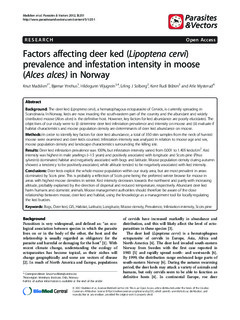| dc.contributor.author | Madslien, Knut | |
| dc.contributor.author | Ytrehus, Bjørnar | |
| dc.contributor.author | Viljugrein, Hildegunn | |
| dc.contributor.author | Solberg, Erling Johan | |
| dc.contributor.author | Bråten, Kent Rudi | |
| dc.contributor.author | Mysterud, Atle | |
| dc.date.accessioned | 2013-01-14T12:10:38Z | |
| dc.date.available | 2013-01-14T12:10:38Z | |
| dc.date.issued | 2012 | |
| dc.identifier.citation | Madslien, K., Ytrehus, B., Viljugrein, H., Solberg, E. J., Bråten, K. R., & Mysterud, A. (2012). Factors affecting deer ked (Lipoptena cervi) prevalence and infestation intensity in moose (Alces alces) in Norway. Parasites & Vectors, 5(1) | no_NO |
| dc.identifier.uri | http://hdl.handle.net/11250/134550 | |
| dc.description.abstract | Background: The deer ked (Lipoptena cervi), a hematophagous ectoparasite of Cervids, is currently spreading in
Scandinavia. In Norway, keds are now invading the south-eastern part of the country and the abundant and widely
distributed moose (Alces alces) is the definitive host. However, key factors for ked abundance are poorly elucidated. The
objectives of our study were to (i) determine deer ked infestation prevalence and intensity on moose and (ii) evaluate if
habitat characteristics and moose population density are determinants of deer ked abundance on moose.
Methods: In order to identify key factors for deer ked abundance, a total of 350 skin samples from the neck of hunted
moose were examined and deer keds counted. Infestation intensity was analyzed in relation to moose age and sex,
moose population density and landscape characteristics surrounding the killing site.
Results: Deer ked infestation prevalence was 100%, but infestation intensity varied from 0.001 to 1.405 keds/cm2. Ked
intensity was highest in male yearlings (~1.5 years) and positively associated with longitude and Scots pine (Pinus
sylvestris) dominated habitat and negatively associated with bogs and latitude. Moose population density during autumn
showed a tendency to be positively associated, while altitude tended to be negatively associated with ked intensity.
Conclusions: Deer keds exploit the whole moose population within our study area, but are most prevalent in areas
dominated by Scots pine. This is probably a reflection of Scots pine being the preferred winter browse for moose in
areas with highest moose densities in winter. Ked intensity decreases towards the northwest and partly with increasing
altitude, probably explained by the direction of dispersal and reduced temperature, respectively. Abundant deer ked
harm humans and domestic animals. Moose management authorities should therefore be aware of the close
relationship between moose, deer ked and habitat, using the knowledge as a management tool for locally regulating
the ked burden. | no_NO |
| dc.language.iso | eng | no_NO |
| dc.publisher | BioMed Central | no_NO |
| dc.relation.uri | http://www.parasitesandvectors.com/content/pdf/1756-3305-5-251.pdf | |
| dc.subject | bogs | no_NO |
| dc.subject | deer ked | no_NO |
| dc.subject | GIS | no_NO |
| dc.subject | habitat | no_NO |
| dc.subject | latitude | no_NO |
| dc.subject | longitude | no_NO |
| dc.subject | moose density | no_NO |
| dc.subject | prevalence | no_NO |
| dc.subject | infestation intensy | no_NO |
| dc.subject | scots pine | no_NO |
| dc.subject | deer | no_NO |
| dc.title | Factors affecting deer ked (Lipoptena cervi) prevalence and infestation intensity in moose (Alces alces) in Norway | no_NO |
| dc.type | Journal article | no_NO |
| dc.type | Peer reviewed | no_NO |
| dc.subject.nsi | VDP::Mathematics and natural science: 400::Zoology and botany: 480 | no_NO |
| dc.source.volume | 5 | no_NO |
| dc.source.journal | Parasites & Vectors | no_NO |
